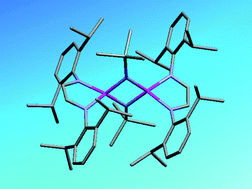The reactivity of gallium-(i), -(ii) and -(iii) heterocycles towards Group 15 substrates: attempts to prepare gallium–terminal pnictinidene complexes
Abstract
The reactivity of a series of Ga(I), Ga(II) and Ga(III) ![[double bond, length as m-dash]](https://www.rsc.org/images/entities/char_e001.gif) NPh led to the unusual anionic spirocyclic complexes, [{κ2P,P′-(PhP)4}Ga{[N(Ar)C(H)]2}]− and [{κ2N,C-PhNN(H)(C6H4)}Ga{[N(Ar)C(H)]2}]−, via formal reductions of the Group 15 substrate. The reaction of the digallane(4), [Ga{[N(Ar)C(H)]2}]2, with (Me3Si)N3 afforded the paramagnetic, dimeric imido–
NPh led to the unusual anionic spirocyclic complexes, [{κ2P,P′-(PhP)4}Ga{[N(Ar)C(H)]2}]− and [{κ2N,C-PhNN(H)(C6H4)}Ga{[N(Ar)C(H)]2}]−, via formal reductions of the Group 15 substrate. The reaction of the digallane(4), [Ga{[N(Ar)C(H)]2}]2, with (Me3Si)N3 afforded the paramagnetic, dimeric imido–![[double bond, length as m-dash]](https://www.rsc.org/images/entities/char_e001.gif) PMes*}{[N(Ar)C(H)]2˙}]. The possible mechanisms of all reactions are discussed, all new complexes have been crystallographically characterised and all paramagnetic complexes have been studied by
PMes*}{[N(Ar)C(H)]2˙}]. The possible mechanisms of all reactions are discussed, all new complexes have been crystallographically characterised and all paramagnetic complexes have been studied by


 Please wait while we load your content...
Please wait while we load your content...